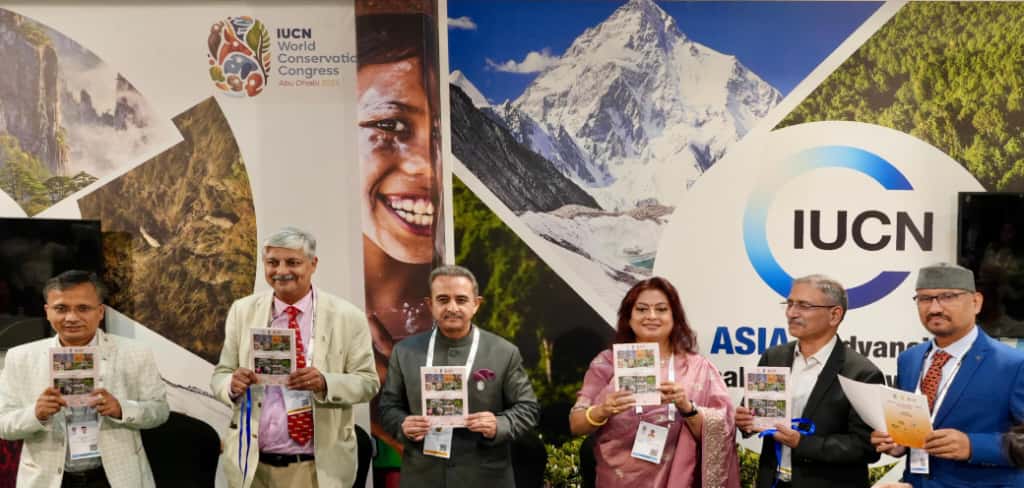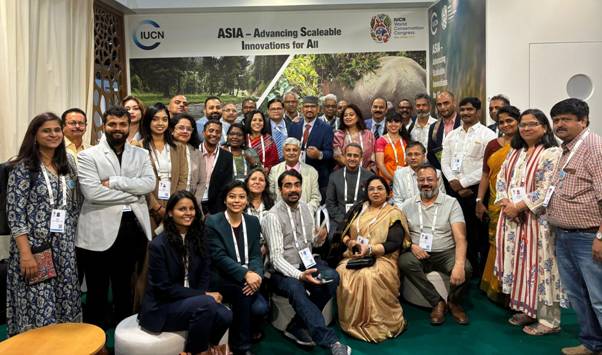Ministry of Environment, Forest and Climate Change
Union MoS Shri Kirti Vardhan Singh leads Indian Delegation at the IUCN World Conservation Congress in Abu Dhabi and launches India’s National Red List Roadmap
India has launched the National Red List Assessment initiative to fulfil commitments under the Convention on Biological Diversity (CBD) and the Kunming–Montreal Global Biodiversity Framework (KMGBF): MoS Shri Singh
Initiative to establish a Nationally-coordinated Red-listing System, a tool for accurate Assessment, Conservation planning, and informed Policy Development
Posted On:
09 OCT 2025 6:41PM by PIB Delhi
Inaugurating the programme on the launch of India’s National Red List Roadmap at the IUCN World Conservation Congress in Abu Dhabi today, Union Minister of State for Environment, Forest and Climate Change, Shri Kirti Vardhan Singh noted that the vision document reflects the extraordinary efforts of India in biodiversity documentation, threat assessment, and conservation. He referred to the IUCN event as a gathering that embodies our collective commitment to safeguarding nature and shaping a sustainable future.

The Minister presented India’s Vision 2025–2030 for the National Red List Assessment (NRLA), a comprehensive framework prepared by the Zoological Survey of India (ZSI) and the Botanical Survey of India (BSI), in close collaboration with IUCN-India and the Centre for Species Survival, India. “This vision outlines our roadmap for a nationally coordinated, inclusive and science-based system to assess and monitor the conservation status of our species”, he stated.
Addressing the session, the Minister informed that India stands proudly among the world’s 17 megadiverse countries, home to four of the 36 global biodiversity hotspots: the Himalayas, the Western Ghats, Indo-Burma, and Sundaland. Although India occupies only 2.4% of the world’s land area, it harbours nearly 8% of the global flora and 7.5% of global fauna, with 28% of the plants and over 30% of the animals being endemic. India has long upheld robust legal frameworks for protection of biodiversity, foremost among them, the Wild Life (Protection) Act, 1972, recently amended in 2022 to extend protection to species listed under CITES appendices, he stated.
“To fulfil our commitments under the Convention on Biological Diversity (CBD) and the Kunming–Montreal Global Biodiversity Framework (KM-GBF), India has launched the National Red List Assessment initiative, aligned with IUCN global standards”, Shri Singh stated. This initiative will establish a nationally coordinated red-listing system, a tool for accurate assessment, conservation planning, and informed policy development. The Minister further laid stress on the important role of documentation of traditional knowledge in biodiversity conservation.

Giving more details on the initiative, the Minister informed that the goal is to publish National Red Data Books for both flora and fauna by 2030, forming a cornerstone for evidence-based conservation, development planning, and threat mitigation. “India is poised to accomplish a landmark initiative, the comprehensive threat assessment of its native species, by adhering to the globally accepted and scientifically robust guidelines established by the IUCN”, he added.
The National Red List Assessment of Indian flora and fauna will be a first-of-its-kind national endeavor, spearheaded by the MoEFCC, Government of India, with the Zoological Survey of India (ZSI) and the Botanical Survey of India (BSI) serving as the nodal agencies. Some Asian nations such as Bangladesh, Sri Lanka, and China have undertaken similar multi-taxa assessments. But India’s National Red List Assessment will distinguish itself as one of the most comprehensive and collaborative national efforts, bringing together the country’s leading taxonomists, conservation biologists, and subject experts under a unified, nationally coordinated framework to accomplish this significant task.
The Minister informed that at the heart of this effort lies the precision of species identification, an area where our taxonomic institutions, the ZSI and BSI, excel. This initiative will further strengthen collaboration among taxonomists, conservation scientists, and policymakers to ensure that conservation decisions rest on sound science. “Through this initiative, India reaffirms its strong commitment to biodiversity conservation and to the global sustainability agenda. The National Red List Assessment is a landmark step toward this vision, embodying a science-based, equitable, and people-centric approach to conservation. Through strong partnerships, rigorous data, and collective will, India will continue to inspire and collaborate with the world to protect our shared natural heritage.

*****
VM/SK
(Release ID: 2176948)
Visitor Counter : 3606